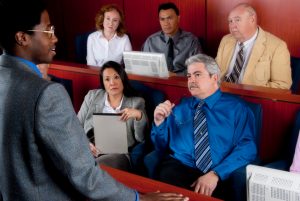Just how to Improve Your Situation with Compelling Trial Presentations: Expert Tips for Attorney
Browsing the Intricacies of Test Presentations: Tips for Seamless Distribution and Engaging Arguments
In the realm of lawful procedures, the art of test discussion stands as a crucial factor of success. The complexities inherent in trial presentations require a fragile balance of skill, finesse, and strategy.

Comprehending Trial Objectives
To properly navigate a trial, it is essential to have a clear understanding of the goals that require to be achieved. Prior to entering the court, legal teams have to define their goals and wanted results. These purposes work as guiding principles throughout the trial, shaping techniques and affecting decision-making procedures.
Recognizing trial purposes includes a detailed evaluation of the situation, legal precedents, and the client's benefits. Trial Presentations. It calls for a careful examination of the facts, recognizing crucial problems, and expecting potential difficulties. By setting details and quantifiable objectives, attorneys can tailor their presentations and debates to line up with the preferred results
Furthermore, a clear grip of trial objectives allows legal groups to focus on evidence, witnesses, and lawful debates efficiently. It enables for the growth of a meaningful narrative that reverberates with the court and court, reinforcing the overall case presentation.

Organizing Evidence Effectively
Having a clear understanding of trial goals lays the foundation for arranging evidence efficiently in legal process - Trial Presentations. By aligning the presentation of evidence with the desired results of the trial, lawful groups can strengthen their arguments and boost their persuasiveness. One critical facet of organizing evidence is classification. Grouping proof based upon styles or importance to particular lawful aspects can assist streamline the discussion and make intricate information extra digestible for the judge or court.
Another crucial element in organizing evidence efficiently is developing a rational circulation. Offering evidence in a consecutive and coherent manner can aid build an engaging narrative that supports the legal debates being made. In addition, using visual help such as charts, graphes, or timelines can additionally boost the organization of evidence and help in making clear complex connections or series of occasions.
In addition, making sure that all proof presented is appropriate and admissible to the case is important. Inadmissible or unimportant evidence can interfere with the stamina of the debate and possibly harm the reliability of the here and now party. A precise evaluation and selection process should be taken on to consist of only the most lawfully sound and impactful proof in the trial presentation.
Crafting Influential Stories
Crafting engaging narratives plays a pivotal function in presenting persuasive arguments during lawful proceedings. When building a story for a trial presentation, it is important to develop a clear story that highlights crucial factors and attaches them in a coherent fashion. By weaving together evidence, testimony, and lawful debates into a influential and cohesive narrative, Get More Information lawful experts can properly support for their clients and enhance the chance of a favorable end result in the court room.
Understanding Visual Aids
Reliable use aesthetic help is crucial to boosting the impact and clarity of trial presentations. Visual help, when made use of strategically, have the power to simplify complicated information, strengthen vital points, and leave a long lasting impression on the judge and court. To understand aesthetic help in trial discussions, it is crucial to make certain that they are clear, concise, and pertinent to the disagreements being made.
When including visual help, such as charts, timelines, charts, or photographs, into a test discussion, it is vital to maintain them aesthetically appealing yet expert. The visuals ought to complement the verbal arguments, providing an aesthetic depiction of the details being talked about without frustrating the target market with unneeded information.
In addition, experimenting the visual help in advance is essential to make sure a smooth distribution during the test. Acquainting oneself with the material, changes, and timings of each aesthetic aid can aid preserve the circulation of the presentation and protect against technical glitches that might occur.
Delivering Impactful Closing Debates
A compelling closing argument serves as the culmination of a trial presentation, enveloping the core narrative and persuading the judge and jury towards a favorable decision. Begin by describing the primary disagreements that sustain your client's setting, highlighting why the evidence presented throughout the trial supports your story.
Additionally, integrating sob story can even more reinforce your closing disagreement. By connecting and humanizing the instance on a personal degree with the decision-makers, you can evoke empathy and understanding, influencing their assumption of their website the facts visit the website presented. Furthermore, reiterating the legal requirements that need to be met for a desirable judgment can enhance the credibility of your placement. Eventually, a well-crafted closing argument should leave an enduring impact, compelling the court and jury to rule in your customer's favor.
Final Thought
To conclude, understanding test presentations entails comprehending purposes, arranging evidence, crafting narratives, utilizing visual help, and delivering impactful closing debates. By applying these strategies effectively, lawyers can offer their situation seamlessly and make engaging arguments in the courtroom. It is important to navigate the complexities of trial discussions with precision and skill to accomplish success in lawful process.
By straightening the discussion of proof with the wanted results of the trial, legal groups can enhance their debates and improve their persuasiveness (Trial Presentations). To grasp visual help in trial presentations, it is crucial to make certain that they are clear, concise, and relevant to the arguments being made
An engaging closing disagreement offers as the end result of a trial discussion, encapsulating the core story and encouraging the court and court towards a positive choice. Begin by describing the main disagreements that sustain your client's position, stressing why the evidence provided throughout the test sustains your narrative.In verdict, understanding test discussions involves recognizing purposes, arranging proof, crafting stories, using aesthetic aids, and supplying impactful closing disagreements.